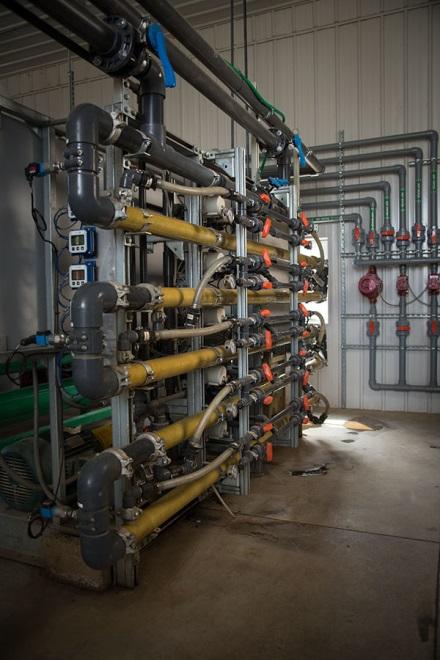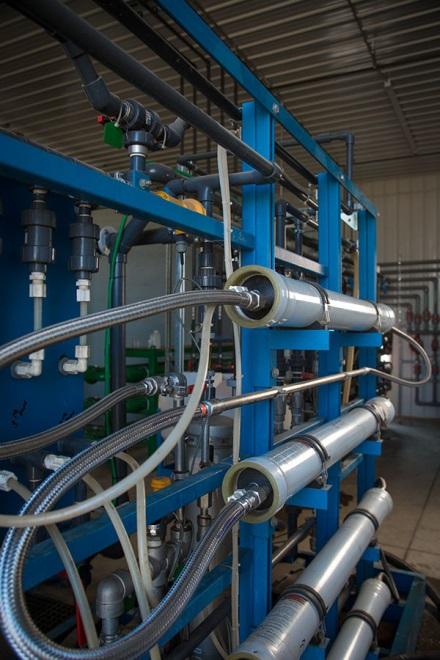Why Study Dairy Manure Treatment?
Dairy manure has historically been land applied consistent with the agronomic requirements of growing crops. Due to consolidation of the dairy industry over the last 40 years, animal density has increased dramatically creating logistical, storage and environmental challenges. Also, environmental constraints and water scarcity is more recognized. Manure maintains tremendous nutrient value; however, water comprises approximately 90% of the manure stream. Development of new and innovative methods for extracting nutrients for beneficial reuse while preparing water for beneficial on-site reuse is of paramount importance to the future of the US dairy industry.
What Did We Do?
Figure 1. The 4 steps that make up the McLanahan Nutrient Separation System

Research was initiated in 2004 to evaluate the potential of coupling a traditional complete mix digester with an ultrafiltration system to create what is commonly referred to as an anaerobic membrane bioreactor (AnMBR).
The AnMBR acts to separate hydraulic retention time from solid retention time while producing a high quality effluent. There are opposing views in the literature with respect to the impact of pump/membrane shear on biological activity and our objective was to add clarity. An outcome of the research was that biogas production is negatively impacted by high shear forces but at practical flow rates, the impact is negligible. An additional finding, and the focus of this paper, is the recognition that the AnMBR is a logical starting point for a comprehensive nutrient recovery and water reuse process.
 |
| Figure 2. Pretreatment Digester |
 |
| Figure 3. Ultrafiltration |
Based on this early research, a comprehensive Nutrient Management System has been developed that seeks to improve the social and environmental sustainability of the dairy industry, while reducing the cost and liability associated with manure management. In general, nutrients are separated and concentrated, allowing for application where and when they are needed. The separated water can be land irrigated, re-used or even discharged. The system is comprised of four steps (as depicted in Figure 1): pretreatment under anaerobic conditions (Figure 2), ultrafiltration (UF) (Figure 3), air stripping (Figure 4) and reverse osmosis (RO) (Figure 5).
 |
| Figure 4. Air Stripping |
The pretreatment system (anaerobic digester) and UF system are coupled together (AnMBR). The manure fed to the AnMBR first undergoes sand separation (only for dairies bedding with sand) followed by solid separation to remove coarse solids to prevent plugging of the UF system. The digester portion of the AnMBR produces a homogeneous feedstock while producing biogas useful for energy production, although its production is a secondary concern of the process. There are two outputs from the UF process: permeate and concentrate. The permeate stream, often referred to as “tea water”, is devoid of suspended solids and contains the dissolved constituents found in manure including ammonia and potassium. The concentrate stream contains 95%+ of the phosphorus and 88%+ of organic nitrogen with a total solid content of 6-7%. Due to the shearing action of the pump/membrane system coupled with anaerobic degradation, the resulting concentrate stream is readily pumped and the solid fraction tends to stay in suspension.
 |
| Figure 5. Reverse Osmosis |
Permeate from the UF flows to an air stripping process for ammonia removal. The equilibrium relationship between un-ionized and ionized NH3+/NH4 is controlled by pH and temperature. As a general rule, the air stripper is used to remove as much ammonia as practical through the addition of waste heat (such as from an engine generator set or biogas boiler). The stripped ammonia is combined with dilute sulfuric acid to produce liquid ammonium sulfate (approximately 6% nitrogen and 7% sulfur).
The air stripped water is fed to a RO process which produces clean water suitable for direct discharge and a concentrated liquid fertilizer containing the potassium. The clean water represents approximately 55% of the starting volume of manure. As an option, a plate and frame press can be used to dewater UF concentrate to produce a solid product containing phosphorus and organic nitrogen. Inclusion of this technology offers the potential of increasing the percentage of clean water produced by the complete process to more than 60% of the starting volume of manure.
What have you learned?
- UF membrane excludes 95%+ of phosphorus and 88%+ of organic nitrogen.
- Stable flux rates at operating total solid concentrations of 6.0-7.0%.
- Ammonium sulfate concentrations of 28-30% were readily achieved.
- Overall, approximately 55% of water is recovered as discharge quality
- Through the use of solid-liquid separation, the potential exists to increase volume of recovered water to 60%+.
Impact of Technology
The technology is flexible and can be applied to meet farm specific goals objectives. Separated and concentrated nutrients can be land applied where and when they are needed and the production of clean water creates new and improved opportunities for water management. Overall, the process vastly improves the farmer’s control of the manure management process.
Authors
James Wallace, P.E., PhD, Environmental Engineer, McLanahan Corporation JWallace@mclanahan.com
Steven Safferman, P.E., PhD, Associate Professor, Michigan State University
The authors are solely responsible for the content of these proceedings. The technical information does not necessarily reflect the official position of the sponsoring agencies or institutions represented by planning committee members, and inclusion and distribution herein does not constitute an endorsement of views expressed by the same. Printed materials included herein are not refereed publications. Citations should appear as follows. EXAMPLE: Authors. 2015. Title of presentation. Waste to Worth: Spreading Science and Solutions. Seattle, WA. March 31-April 3, 2015. URL of this page. Accessed on: today’s date.

